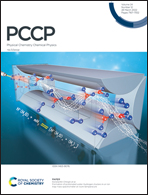Optimized hot electron injection from Cu nanoparticles to S-doped C3N4 by the formed S–Cu bonds for an enhanced photocatalytic performance†
Abstract
Low-cost and high-abundance Cu nanostructures are potential near-infrared (NIR) surface plasmonic resonance (SPR) photosensitizers for carbon nitride (C3N4) photocatalysts, but their low activity and stability need to be improved. In this article, doping S into C3N4 (S-C3N4) creates anchoring sites for photo-deposited Cu nanoparticles (NPs), and the spontaneous construction of S-Cu bonds is realized between S-C3N4 and Cu NPs. The optimal hydrogen evolution rate of 1.64 mmol g−1 h−1 is obtained for S-C3N4–Cu, which is 5.5, 4.6 and 1.7 times that of pure C3N4, S-C3N4 and S-C3N4–Cu, respectively. With further loading of a Pt co-catalyst to confirm the role of Cu NPs and improve the photocatalytic activity of the SCN–Cu, the photocatalytic rate can reach up to 14.34 mmol g−1 h−1. Due to the NIR SPR effect of Cu NPs, the apparent quantum efficiency (AQE) of S-C3N4–Cu at 600 and 765 nm is 2.02% and 0.47%, respectively. The enhanced photocatalytic performance of S-C3N4–Cu compared with C3N4–Cu is mainly due to the introduced S–Cu bonds that improve the injection rate of hot electrons. This solution provides a simple and efficient interface optimization strategy for the construction of efficient NIR-driven photocatalysts.



 Please wait while we load your content...
Please wait while we load your content...